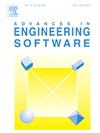HFJOINT: A high-fidelity numerical modeling tool for stress concentration factor analysis of welded tubular joints
IF 5.7
2区 工程技术
Q2 COMPUTER SCIENCE, INTERDISCIPLINARY APPLICATIONS
引用次数: 0
Abstract
Assessing the fatigue performance of welded tubular joints is crucial to the safety and durability of their host structures. Fast-computing beam-element models are insufficient to accurately capture local stress concentrations at the intersection region, leading to inaccurate lifetime predictions. In this work, a high-fidelity numerical modeling tool, HFJOINT, is developed for stress concentration analysis of welded tubular joints, following a user-friendly process. The workflow begins with the creation of an elementary T/Y-joint using quadratic hexahedron elements, where the weld geometry is generated in accordance with the American Welding Society (AWS) standard. The chord and brace are divided into several regions allowing for an entirely structured mesh. The geometric transformations of multiple elementary joints enable creating more complex joints. After evaluating the stiffness matrix, the beam-element forces are converted to external tractions, and are transformed into solid-element nodal forces via Gaussian integral. The boundary conditions are defined from the geometric constraints formulated by the Lagrange’s equation of the second kind. Based on the nodal displacements, the postprocessing module evaluates the local stress at any point. Using linear extrapolation, the hot-spot structural stress and the stress concentration factors (SCFs) along the weld circumference are computed. The workflow has a computational complexity of . The mesh convergence shows that the relative changes are below 2% when refining the weld circumference from 64 to 96 segments. The tool is verified against the SCFs of benchmark T-, K- and X- joint models, showing its potential for fatigue analysis of welded tubular joints in broad applications.
HFJOINT:用于管状焊接接头应力集中系数分析的高保真数值模拟工具
评估焊接管接头的疲劳性能对其主体结构的安全性和耐久性至关重要。快速计算的梁单元模型不足以准确捕获交叉区域的局部应力集中,导致不准确的寿命预测。在这项工作中,开发了一个高保真的数值建模工具HFJOINT,用于焊接管状接头的应力集中分析,遵循用户友好的过程。工作流程从使用二次六面体元素创建基本T/ y型接头开始,其中根据美国焊接协会(AWS)标准生成焊缝几何形状。弦和支撑被分成几个区域,允许一个完全结构化的网格。多个初等关节的几何变换可以创建更复杂的关节。计算刚度矩阵后,将梁单元力转换为外部牵引力,并通过高斯积分转换为实体单元节点力。边界条件由第二类拉格朗日方程所表示的几何约束来定义。根据节点位移,后处理模块计算任意点的局部应力。采用线性外推法,计算了焊缝周边的热点结构应力和应力集中系数。工作流的计算复杂度为0 (N1.89)。网格收敛表明,当焊缝周长从64段细化到96段时,相对变化小于2%。该工具通过T型、K型和X型接头模型的scf验证,显示了其在焊接管接头疲劳分析中的广泛应用潜力。
本文章由计算机程序翻译,如有差异,请以英文原文为准。
求助全文
约1分钟内获得全文
求助全文
来源期刊

Advances in Engineering Software
工程技术-计算机:跨学科应用
CiteScore
7.70
自引率
4.20%
发文量
169
审稿时长
37 days
期刊介绍:
The objective of this journal is to communicate recent and projected advances in computer-based engineering techniques. The fields covered include mechanical, aerospace, civil and environmental engineering, with an emphasis on research and development leading to practical problem-solving.
The scope of the journal includes:
• Innovative computational strategies and numerical algorithms for large-scale engineering problems
• Analysis and simulation techniques and systems
• Model and mesh generation
• Control of the accuracy, stability and efficiency of computational process
• Exploitation of new computing environments (eg distributed hetergeneous and collaborative computing)
• Advanced visualization techniques, virtual environments and prototyping
• Applications of AI, knowledge-based systems, computational intelligence, including fuzzy logic, neural networks and evolutionary computations
• Application of object-oriented technology to engineering problems
• Intelligent human computer interfaces
• Design automation, multidisciplinary design and optimization
• CAD, CAE and integrated process and product development systems
• Quality and reliability.
 求助内容:
求助内容: 应助结果提醒方式:
应助结果提醒方式:


